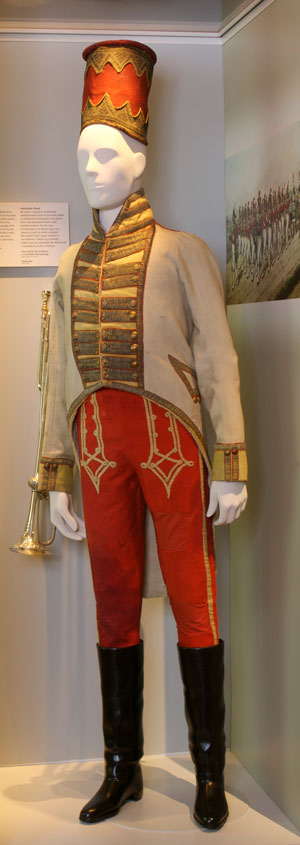Kilkenny Militia band uniform
Published in Artefacts, Issue 2 (March/April 2024), Volume 32By Eamonn O’Keeffe

Above: The Kilkenny Militia uniform on display in the Soldiers and Chiefs exhibition in the National Museum, Collins Barracks.(NMI)
The Soldiers and Chiefs exhibition in Dublin’s Collins Barracks houses a polychromatic uniform of the Kilkenny Militia with a provenance no less colourful. Saved by an antiquarian from the ignominious fate of adorning a garden scarecrow, it is a striking testament to the remarkable crescendo of martial music in Ireland prompted by the French Revolutionary and Napoleonic Wars (1793–1815). Officers of the expanded British army and newly raised Irish militia regiments invested heavily in military bands, regarding them as valuable social amenities, vital for men’s morale and pre-eminent symbols of unit prestige. These ensembles featured wind instruments such as clarinets, horns and bassoons alongside percussion instruments inspired by Ottoman precedents, which were often played by black soldiers clad in quasi-Moorish attire. Individual units engaged in a fierce musical arms race: they hired expensive foreign musical instructors, purchased increasingly elaborate outfits and fielded bands of as many as 21 performers. Few regiments, however, could match the musicians of the Kilkenny Militia. Bankrolled by the Earl of Ormonde, the band was praised by one officer as ‘the finest in the army’, though he could not say ‘whether it was the splendour of their uniform, or the beauty of their music, that at all times attracted so great a crowd about them’.
Besides providing parade ground pageantry, military bands enlivened myriad public events in Irish garrison towns, including balls, concerts and charity sermons. Their extensive repertoires encompassed not only military marches but also dance tunes, theatrical songs, Scottish and Irish ballads, and selections from modish Continental composers. The prevalence of free open-air performances by regimental bands appears to have stimulated popular interest in music. A contributor to the Cork Standard and Evening Herald, writing in 1840, praised the ensembles of the wartime Irish militia for honing ‘the musical taste of our citizens for which they are still proverbial’.
Despite their evident popularity with socially diverse audiences, military musicians could also encourage sectarianism and political discontent. The sound of so-called ‘party tunes’ such as ‘Protestant Boys’ and ‘Croppies Lie Down’, for example, prompted indignation and brickbats from Catholic listeners. Military musicians also periodically appeared in Orange Order processions, although British authorities ultimately forbade their participation in such divisive displays. On the other side of the coin, drummers and bandsmen of the Irish militia caused upset in Ulster by escorting comrades to Sunday Mass, thereby providing local Protestants with an unwelcome sonic reminder that their security now relied on largely Catholic regiments.
The wartime expansion of military music had palpable ramifications for Irish culture and politics after 1815. Far from being broken up after the guns fell silent, militia bands continued performing at both genteel gatherings and boisterous fairs in peacetime. Men and boys who had honed their talents in uniform subsequently pursued varied musical careers, becoming teachers, retailers and organists, or even opera and cathedral singers. Johann Bernhard Logier, the German-born master of the Kilkenny Militia band, went on to create a network of more than 80 piano schools across Ireland and Britain by 1820. The temperance bands that flourished in Ireland as part of Father Mathew’s teetotal movement in the 1830s and 1840s were often trained by veterans of militia ensembles and clad in military-style dress. Martial drill and pageantry, having become so familiar in wartime, were also appropriated for new political ends, with proponents of tithe abolition, Catholic Emancipation and the repeal of the Union relying on quasi-military music to marshal supporters. Thus the sounds that broadcast British authority in wartime Ireland also came to underpin the mass political movements that challenged the status quo in the decades after Waterloo.
Eamonn O’Keeffe is a National Army Museum Junior Research Fellow at Queens’ College, Cambridge.
















